Solved assignments on Marketing Management and Queuing Theory
VerifiedAdded on 2023/06/13
|6
|914
|268
AI Summary
This document contains solved assignments on Marketing Management and Queuing Theory. It includes solutions to problems related to service rate, waiting time, customer satisfaction, and more. The assignments cover topics such as probability of idle service facility, number of customers in waiting line, average time waiting for service, and total cost of consultants. The assignments also suggest ways to improve the system and meet service goals.
Contribute Materials
Your contribution can guide someone’s learning journey. Share your
documents today.
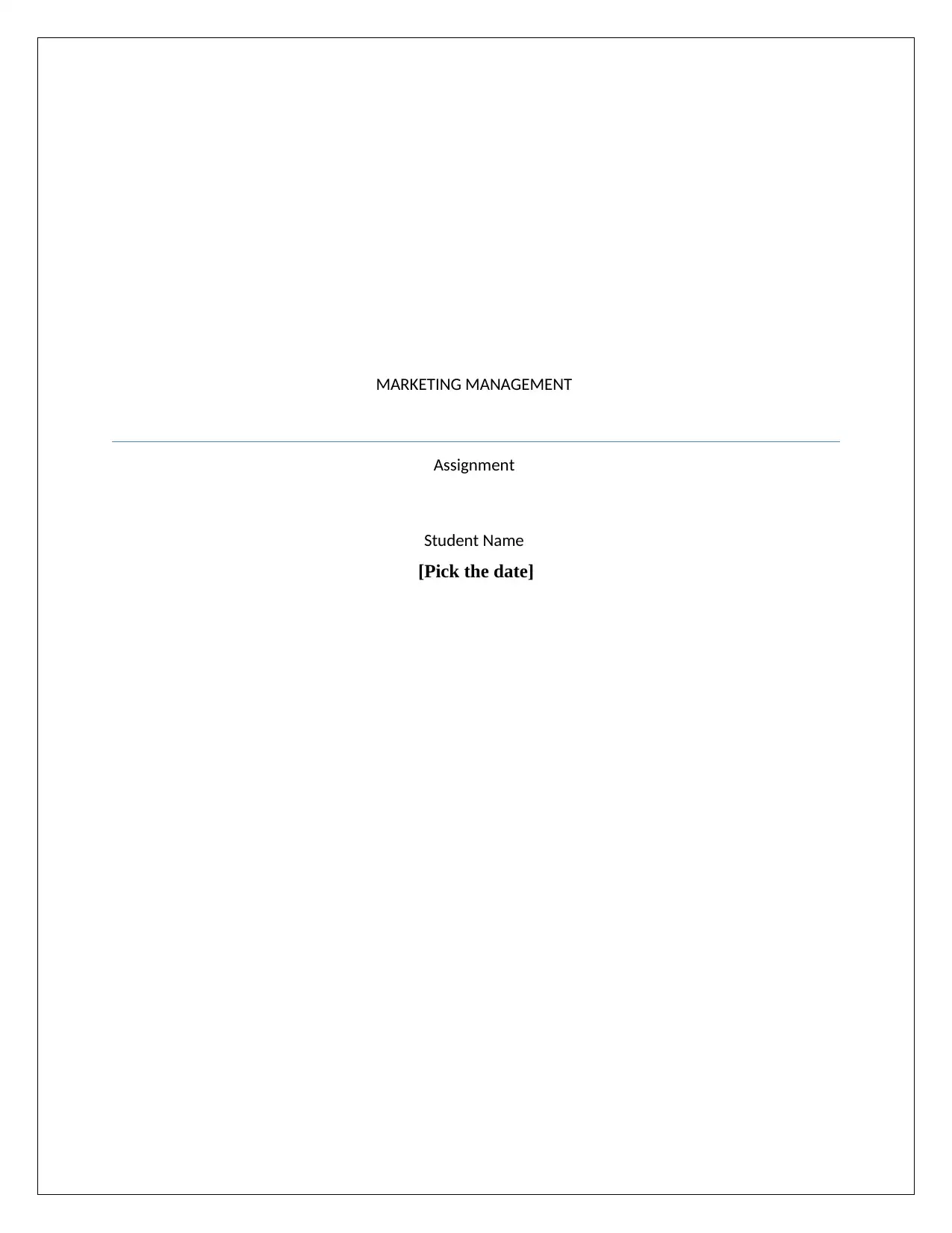
MARKETING MANAGEMENT
Assignment
Student Name
[Pick the date]
Assignment
Student Name
[Pick the date]
Secure Best Marks with AI Grader
Need help grading? Try our AI Grader for instant feedback on your assignments.
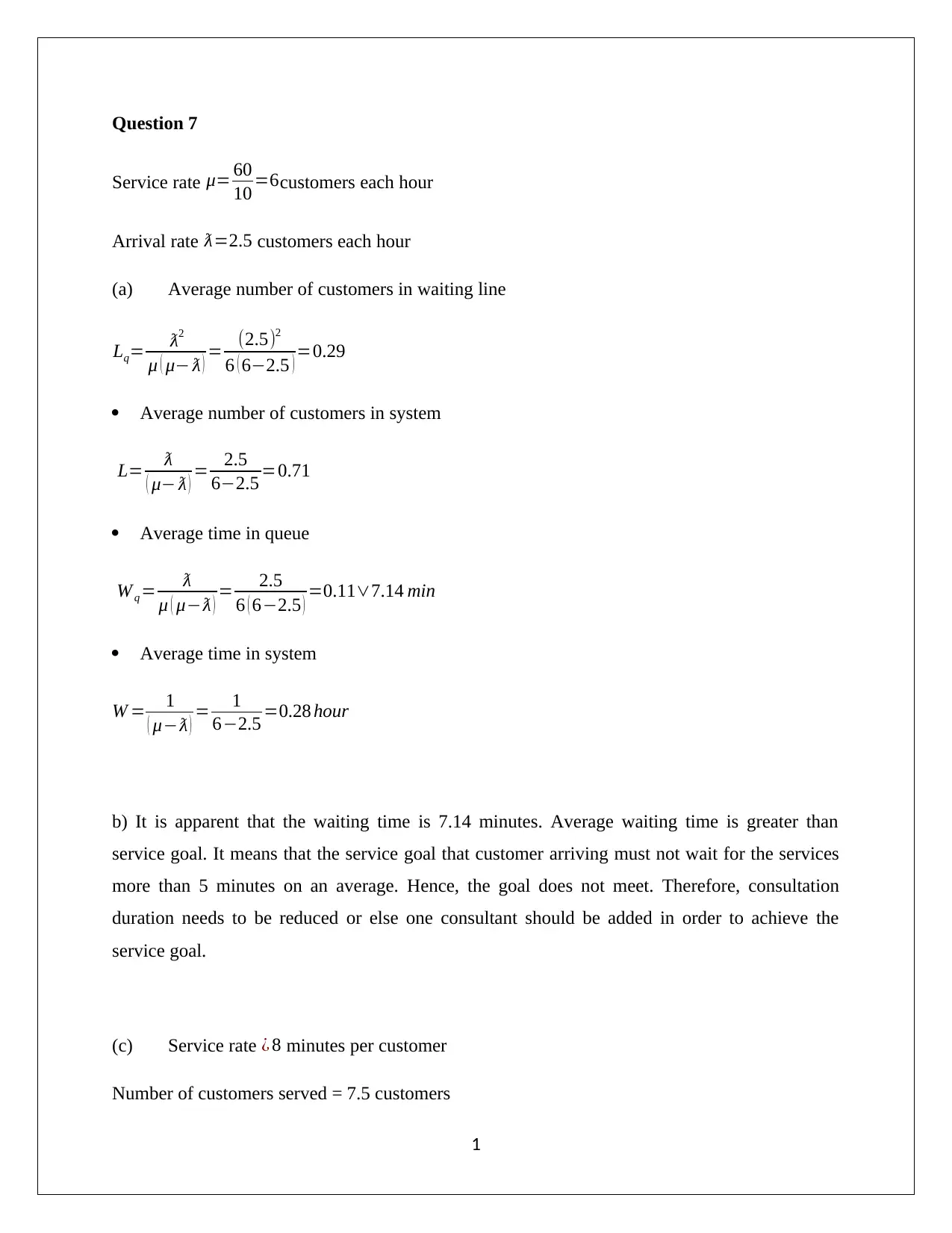
Question 7
Service rate μ= 60
10 =6customers each hour
Arrival rate ƛ=2.5 customers each hour
(a) Average number of customers in waiting line
Lq= ƛ2
μ ( μ− ƛ ) = (2.5)2
6 ( 6−2.5 ) =0.29
Average number of customers in system
L= ƛ
( μ− ƛ ) = 2.5
6−2.5 =0.71
Average time in queue
W q = ƛ
μ ( μ−ƛ ) = 2.5
6 ( 6−2.5 ) =0.11∨7.14 min
Average time in system
W = 1
( μ−ƛ ) = 1
6−2.5 =0.28 hour
b) It is apparent that the waiting time is 7.14 minutes. Average waiting time is greater than
service goal. It means that the service goal that customer arriving must not wait for the services
more than 5 minutes on an average. Hence, the goal does not meet. Therefore, consultation
duration needs to be reduced or else one consultant should be added in order to achieve the
service goal.
(c) Service rate ¿ 8 minutes per customer
Number of customers served = 7.5 customers
1
Service rate μ= 60
10 =6customers each hour
Arrival rate ƛ=2.5 customers each hour
(a) Average number of customers in waiting line
Lq= ƛ2
μ ( μ− ƛ ) = (2.5)2
6 ( 6−2.5 ) =0.29
Average number of customers in system
L= ƛ
( μ− ƛ ) = 2.5
6−2.5 =0.71
Average time in queue
W q = ƛ
μ ( μ−ƛ ) = 2.5
6 ( 6−2.5 ) =0.11∨7.14 min
Average time in system
W = 1
( μ−ƛ ) = 1
6−2.5 =0.28 hour
b) It is apparent that the waiting time is 7.14 minutes. Average waiting time is greater than
service goal. It means that the service goal that customer arriving must not wait for the services
more than 5 minutes on an average. Hence, the goal does not meet. Therefore, consultation
duration needs to be reduced or else one consultant should be added in order to achieve the
service goal.
(c) Service rate ¿ 8 minutes per customer
Number of customers served = 7.5 customers
1
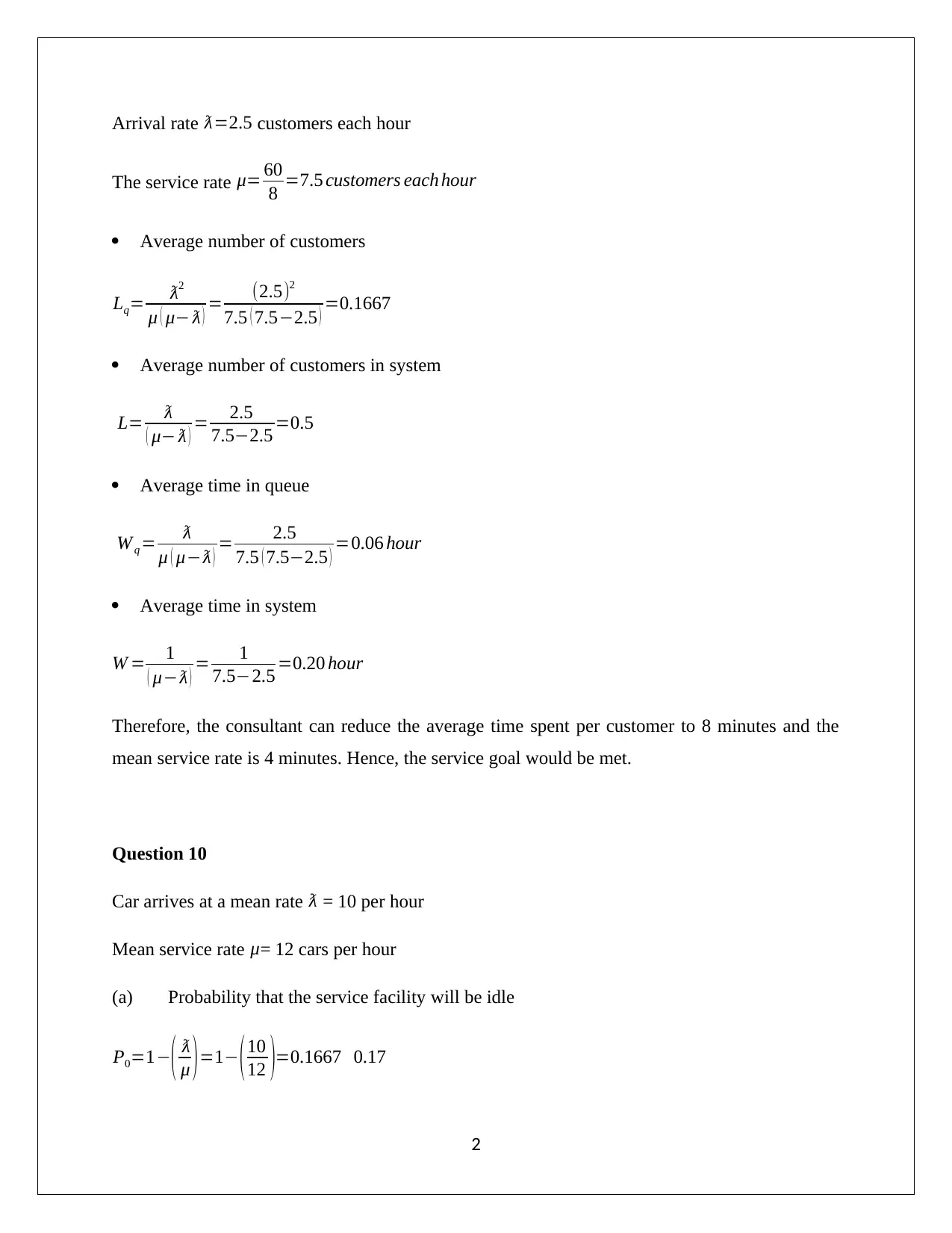
Arrival rate ƛ=2.5 customers each hour
The service rate μ= 60
8 =7.5 customers each hour
Average number of customers
Lq= ƛ2
μ ( μ− ƛ ) = (2.5)2
7.5 ( 7.5−2.5 ) =0.1667
Average number of customers in system
L= ƛ
( μ− ƛ ) = 2.5
7.5−2.5 =0.5
Average time in queue
W q = ƛ
μ ( μ−ƛ ) = 2.5
7.5 ( 7.5−2.5 ) =0.06 hour
Average time in system
W = 1
( μ−ƛ ) = 1
7.5−2.5 =0.20 hour
Therefore, the consultant can reduce the average time spent per customer to 8 minutes and the
mean service rate is 4 minutes. Hence, the service goal would be met.
Question 10
Car arrives at a mean rate ƛ = 10 per hour
Mean service rate μ= 12 cars per hour
(a) Probability that the service facility will be idle
P0=1−( ƛ
μ )=1− (10
12 )=0.1667 0.17
2
The service rate μ= 60
8 =7.5 customers each hour
Average number of customers
Lq= ƛ2
μ ( μ− ƛ ) = (2.5)2
7.5 ( 7.5−2.5 ) =0.1667
Average number of customers in system
L= ƛ
( μ− ƛ ) = 2.5
7.5−2.5 =0.5
Average time in queue
W q = ƛ
μ ( μ−ƛ ) = 2.5
7.5 ( 7.5−2.5 ) =0.06 hour
Average time in system
W = 1
( μ−ƛ ) = 1
7.5−2.5 =0.20 hour
Therefore, the consultant can reduce the average time spent per customer to 8 minutes and the
mean service rate is 4 minutes. Hence, the service goal would be met.
Question 10
Car arrives at a mean rate ƛ = 10 per hour
Mean service rate μ= 12 cars per hour
(a) Probability that the service facility will be idle
P0=1−( ƛ
μ )=1− (10
12 )=0.1667 0.17
2
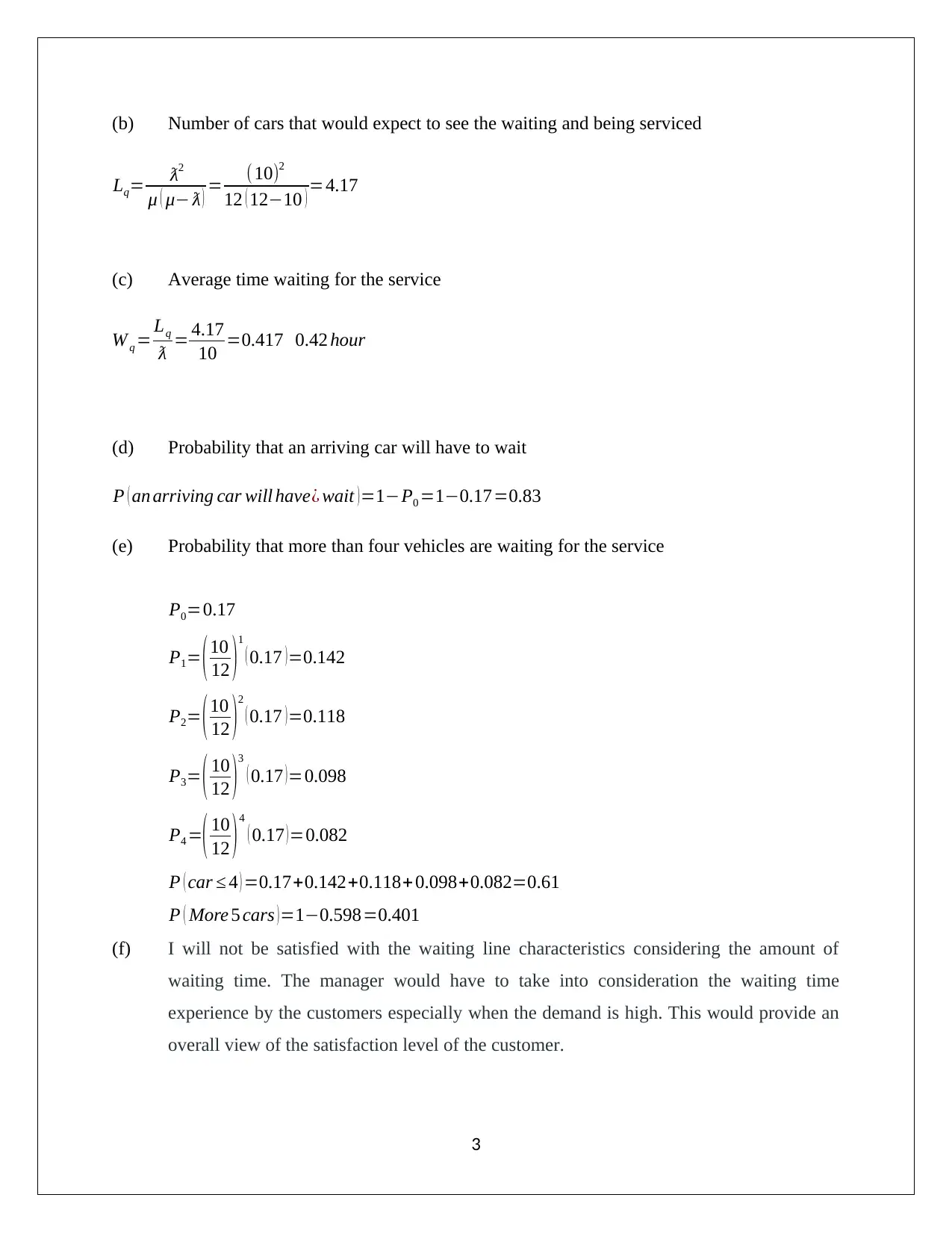
(b) Number of cars that would expect to see the waiting and being serviced
Lq= ƛ2
μ ( μ− ƛ ) = (10)2
12 ( 12−10 ) =4.17
(c) Average time waiting for the service
Wq = Lq
ƛ = 4.17
10 =0.417 0.42 hour
(d) Probability that an arriving car will have to wait
P ( an arriving car will have¿ wait )=1−P0 =1−0.17=0.83
(e) Probability that more than four vehicles are waiting for the service
P0=0.17
P1= ( 10
12 )
1
( 0.17 ) =0.142
P2= (10
12 )2
( 0.17 )=0.118
P3= ( 10
12 )
3
( 0.17 ) =0.098
P4 =( 10
12 )4
( 0.17 )=0.082
P ( car ≤ 4 ) =0.17+0.142+0.118+ 0.098+0.082=0.61
P ( More 5 cars )=1−0.598=0.401
(f) I will not be satisfied with the waiting line characteristics considering the amount of
waiting time. The manager would have to take into consideration the waiting time
experience by the customers especially when the demand is high. This would provide an
overall view of the satisfaction level of the customer.
3
Lq= ƛ2
μ ( μ− ƛ ) = (10)2
12 ( 12−10 ) =4.17
(c) Average time waiting for the service
Wq = Lq
ƛ = 4.17
10 =0.417 0.42 hour
(d) Probability that an arriving car will have to wait
P ( an arriving car will have¿ wait )=1−P0 =1−0.17=0.83
(e) Probability that more than four vehicles are waiting for the service
P0=0.17
P1= ( 10
12 )
1
( 0.17 ) =0.142
P2= (10
12 )2
( 0.17 )=0.118
P3= ( 10
12 )
3
( 0.17 ) =0.098
P4 =( 10
12 )4
( 0.17 )=0.082
P ( car ≤ 4 ) =0.17+0.142+0.118+ 0.098+0.082=0.61
P ( More 5 cars )=1−0.598=0.401
(f) I will not be satisfied with the waiting line characteristics considering the amount of
waiting time. The manager would have to take into consideration the waiting time
experience by the customers especially when the demand is high. This would provide an
overall view of the satisfaction level of the customer.
3
Secure Best Marks with AI Grader
Need help grading? Try our AI Grader for instant feedback on your assignments.
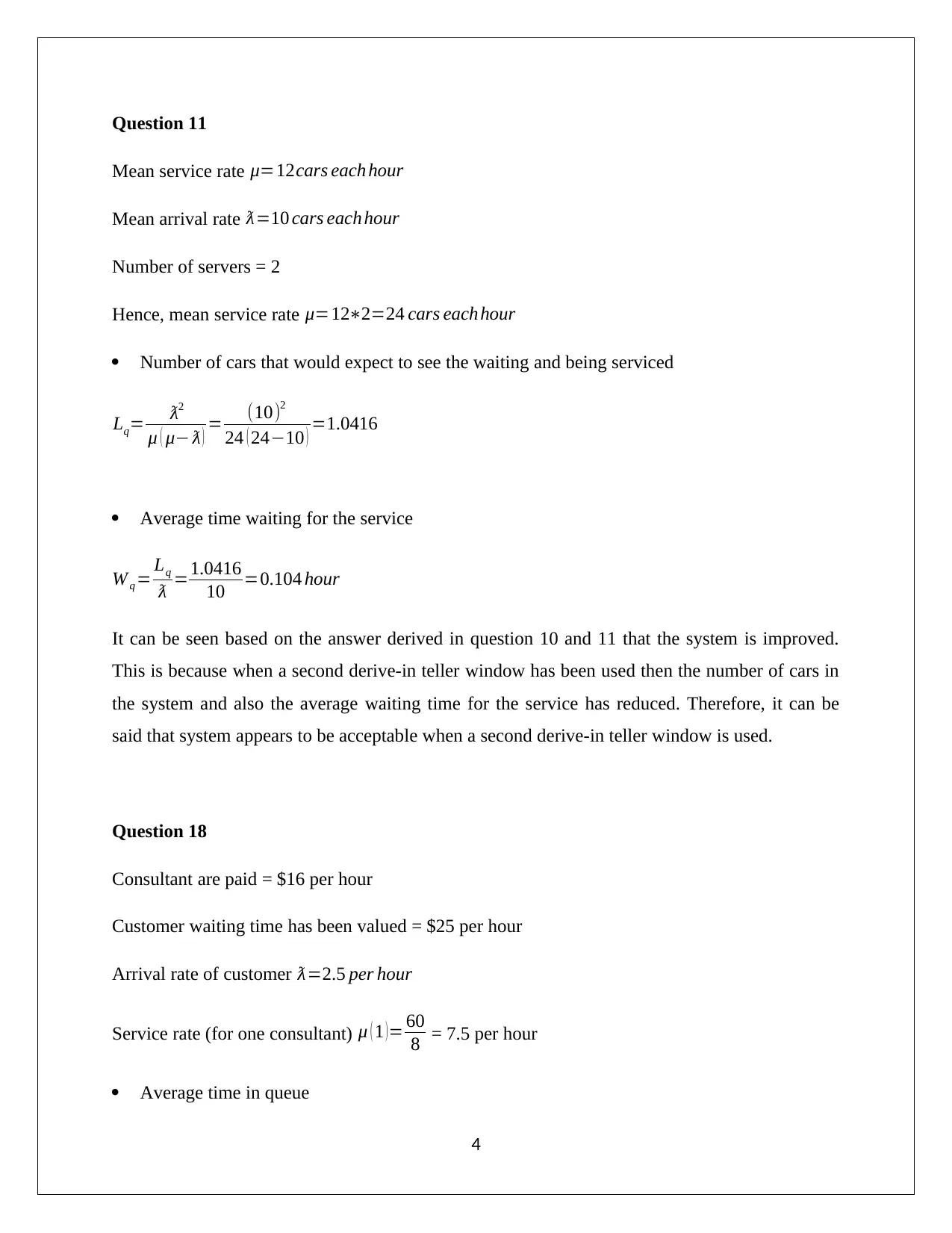
Question 11
Mean service rate μ=12cars each hour
Mean arrival rate ƛ=10 cars each hour
Number of servers = 2
Hence, mean service rate μ=12∗2=24 cars each hour
Number of cars that would expect to see the waiting and being serviced
Lq= ƛ2
μ ( μ− ƛ ) = (10)2
24 ( 24−10 ) =1.0416
Average time waiting for the service
W q = Lq
ƛ =1.0416
10 =0.104 hour
It can be seen based on the answer derived in question 10 and 11 that the system is improved.
This is because when a second derive-in teller window has been used then the number of cars in
the system and also the average waiting time for the service has reduced. Therefore, it can be
said that system appears to be acceptable when a second derive-in teller window is used.
Question 18
Consultant are paid = $16 per hour
Customer waiting time has been valued = $25 per hour
Arrival rate of customer ƛ=2.5 per hour
Service rate (for one consultant) μ ( 1 )= 60
8 = 7.5 per hour
Average time in queue
4
Mean service rate μ=12cars each hour
Mean arrival rate ƛ=10 cars each hour
Number of servers = 2
Hence, mean service rate μ=12∗2=24 cars each hour
Number of cars that would expect to see the waiting and being serviced
Lq= ƛ2
μ ( μ− ƛ ) = (10)2
24 ( 24−10 ) =1.0416
Average time waiting for the service
W q = Lq
ƛ =1.0416
10 =0.104 hour
It can be seen based on the answer derived in question 10 and 11 that the system is improved.
This is because when a second derive-in teller window has been used then the number of cars in
the system and also the average waiting time for the service has reduced. Therefore, it can be
said that system appears to be acceptable when a second derive-in teller window is used.
Question 18
Consultant are paid = $16 per hour
Customer waiting time has been valued = $25 per hour
Arrival rate of customer ƛ=2.5 per hour
Service rate (for one consultant) μ ( 1 )= 60
8 = 7.5 per hour
Average time in queue
4
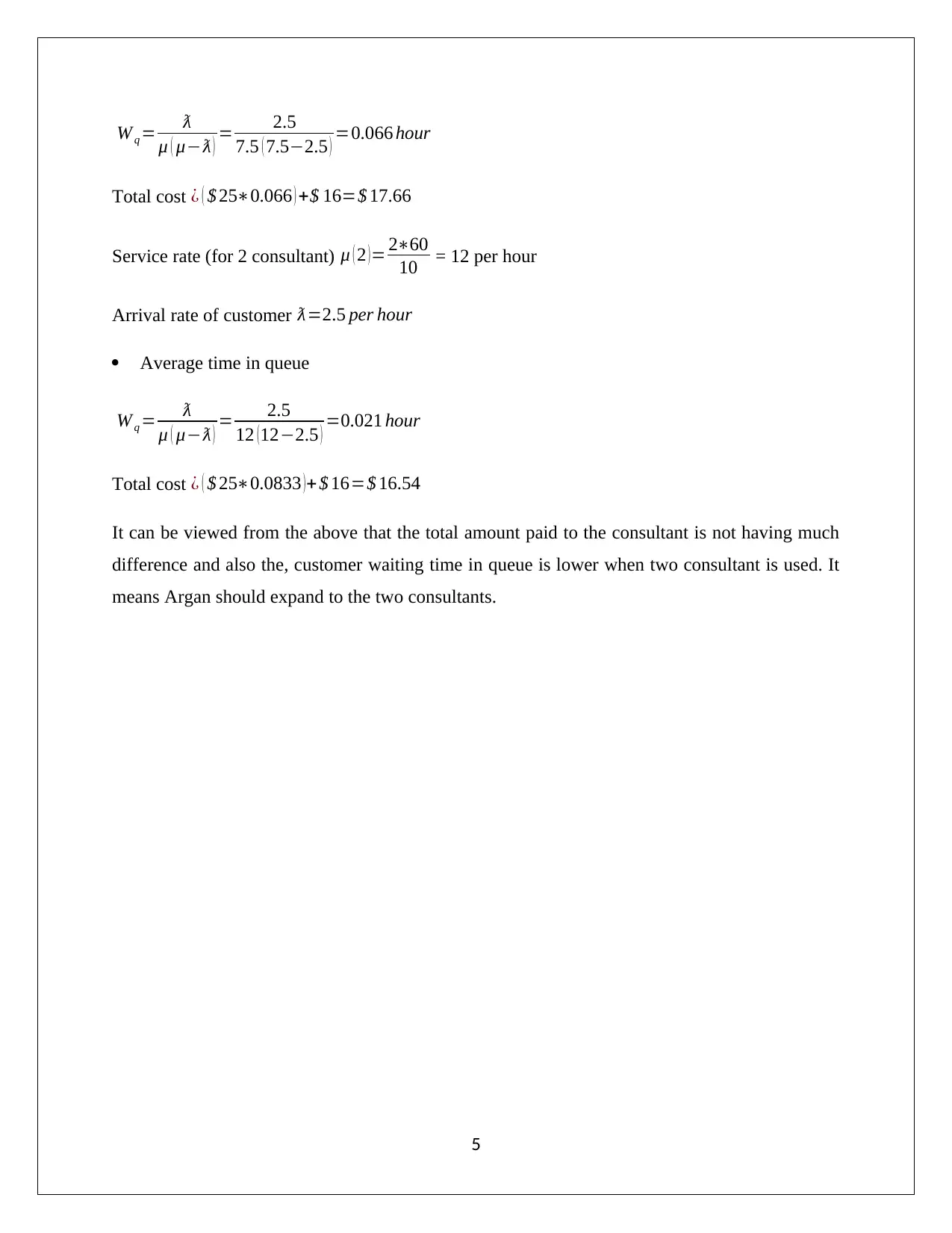
W q = ƛ
μ ( μ−ƛ ) = 2.5
7.5 ( 7.5−2.5 ) =0.066 hour
Total cost ¿ ( $ 25∗0.066 ) +$ 16=$ 17.66
Service rate (for 2 consultant) μ ( 2 )= 2∗60
10 = 12 per hour
Arrival rate of customer ƛ=2.5 per hour
Average time in queue
Wq = ƛ
μ ( μ−ƛ ) = 2.5
12 ( 12−2.5 ) =0.021 hour
Total cost ¿ ( $ 25∗0.0833 ) +$ 16=$ 16.54
It can be viewed from the above that the total amount paid to the consultant is not having much
difference and also the, customer waiting time in queue is lower when two consultant is used. It
means Argan should expand to the two consultants.
5
μ ( μ−ƛ ) = 2.5
7.5 ( 7.5−2.5 ) =0.066 hour
Total cost ¿ ( $ 25∗0.066 ) +$ 16=$ 17.66
Service rate (for 2 consultant) μ ( 2 )= 2∗60
10 = 12 per hour
Arrival rate of customer ƛ=2.5 per hour
Average time in queue
Wq = ƛ
μ ( μ−ƛ ) = 2.5
12 ( 12−2.5 ) =0.021 hour
Total cost ¿ ( $ 25∗0.0833 ) +$ 16=$ 16.54
It can be viewed from the above that the total amount paid to the consultant is not having much
difference and also the, customer waiting time in queue is lower when two consultant is used. It
means Argan should expand to the two consultants.
5
1 out of 6
Related Documents
Your All-in-One AI-Powered Toolkit for Academic Success.
+13062052269
info@desklib.com
Available 24*7 on WhatsApp / Email
![[object Object]](/_next/static/media/star-bottom.7253800d.svg)
Unlock your academic potential
© 2024 | Zucol Services PVT LTD | All rights reserved.
